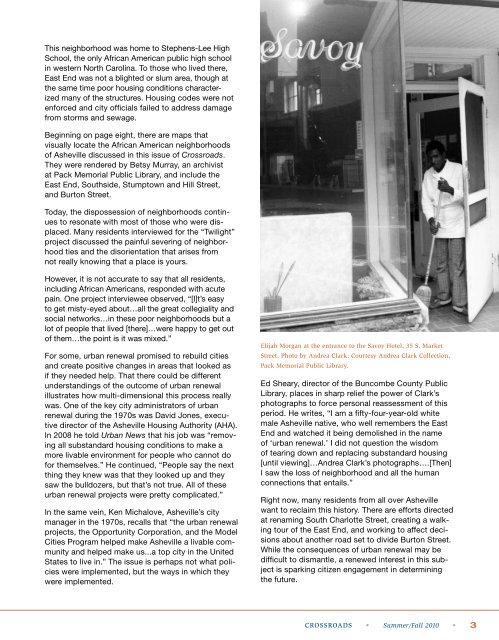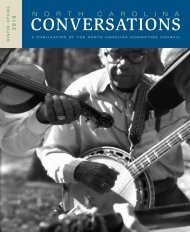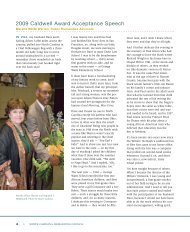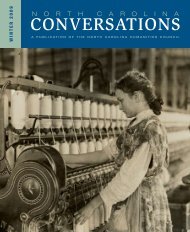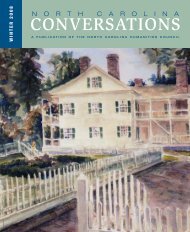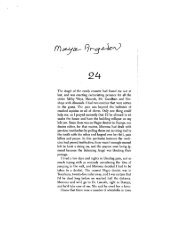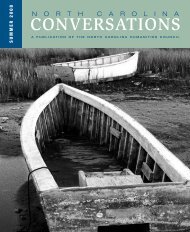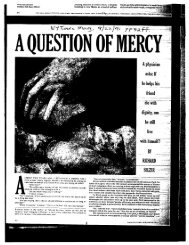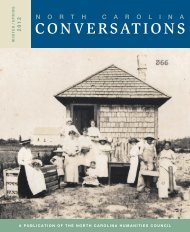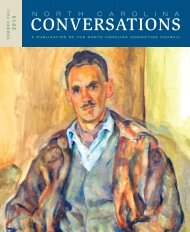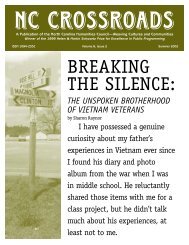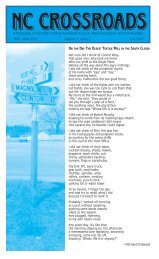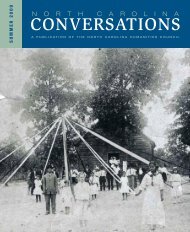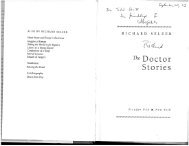Twilight of a Neighborhood - North Carolina Humanities Council
Twilight of a Neighborhood - North Carolina Humanities Council
Twilight of a Neighborhood - North Carolina Humanities Council
You also want an ePaper? Increase the reach of your titles
YUMPU automatically turns print PDFs into web optimized ePapers that Google loves.
This neighborhood was home to Stephens-Lee High<br />
School, the only African American public high school<br />
in western north <strong>Carolina</strong>. To those who lived there,<br />
East End was not a blighted or slum area, though at<br />
the same time poor housing conditions characterized<br />
many <strong>of</strong> the structures. Housing codes were not<br />
enforced and city <strong>of</strong>ficials failed to address damage<br />
from storms and sewage.<br />
Beginning on page eight, there are maps that<br />
visually locate the African American neighborhoods<br />
<strong>of</strong> Asheville discussed in this issue <strong>of</strong> Crossroads.<br />
They were rendered by Betsy Murray, an archivist<br />
at Pack Memorial Public Library, and include the<br />
East End, Southside, Stumptown and Hill Street,<br />
and Burton Street.<br />
Today, the dispossession <strong>of</strong> neighborhoods continues<br />
to resonate with most <strong>of</strong> those who were displaced.<br />
Many residents interviewed for the “<strong>Twilight</strong>”<br />
project discussed the painful severing <strong>of</strong> neighborhood<br />
ties and the disorientation that arises from<br />
not really knowing that a place is yours.<br />
However, it is not accurate to say that all residents,<br />
including African Americans, responded with acute<br />
pain. One project interviewee observed, “[i]t’s easy<br />
to get misty-eyed about…all the great collegiality and<br />
social networks…in these poor neighborhoods but a<br />
lot <strong>of</strong> people that lived [there]…were happy to get out<br />
<strong>of</strong> them…the point is it was mixed.”<br />
For some, urban renewal promised to rebuild cities<br />
and create positive changes in areas that looked as<br />
if they needed help. That there could be different<br />
understandings <strong>of</strong> the outcome <strong>of</strong> urban renewal<br />
illustrates how multi-dimensional this process really<br />
was. One <strong>of</strong> the key city administrators <strong>of</strong> urban<br />
renewal during the 1970s was David Jones, executive<br />
director <strong>of</strong> the Asheville Housing Authority (AHA).<br />
in 2008 he told Urban News that his job was “removing<br />
all substandard housing conditions to make a<br />
more livable environment for people who cannot do<br />
for themselves.” He continued, “People say the next<br />
thing they knew was that they looked up and they<br />
saw the bulldozers, but that’s not true. All <strong>of</strong> these<br />
urban renewal projects were pretty complicated.”<br />
in the same vein, Ken Michalove, Asheville’s city<br />
manager in the 1970s, recalls that “the urban renewal<br />
projects, the Opportunity Corporation, and the Model<br />
Cities Program helped make Asheville a livable community<br />
and helped make us...a top city in the United<br />
States to live in.” The issue is perhaps not what policies<br />
were implemented, but the ways in which they<br />
were implemented.<br />
Elijah Morgan at the entrance to the Savoy Hotel, 35 S. Market<br />
Street. Photo by Andrea Clark. Courtesy Andrea Clark Collection,<br />
Pack Memorial Public Library.<br />
Ed Sheary, director <strong>of</strong> the Buncombe County Public<br />
Library, places in sharp relief the power <strong>of</strong> Clark’s<br />
photographs to force personal reassessment <strong>of</strong> this<br />
period. He writes, “i am a fifty-four-year-old white<br />
male Asheville native, who well remembers the East<br />
End and watched it being demolished in the name<br />
<strong>of</strong> ‘urban renewal.’ i did not question the wisdom<br />
<strong>of</strong> tearing down and replacing substandard housing<br />
[until viewing]…Andrea Clark’s photographs….[Then]<br />
i saw the loss <strong>of</strong> neighborhood and all the human<br />
connections that entails.”<br />
right now, many residents from all over Asheville<br />
want to reclaim this history. There are efforts directed<br />
at renaming South Charlotte Street, creating a walking<br />
tour <strong>of</strong> the East End, and working to affect decisions<br />
about another road set to divide Burton Street.<br />
while the consequences <strong>of</strong> urban renewal may be<br />
difficult to dismantle, a renewed interest in this subject<br />
is sparking citizen engagement in determining<br />
the future.<br />
CROSSROADS • Summer/Fall 2010 • 3


